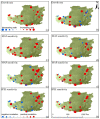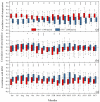Climatic Warming-Induced Drought Stress Has Resulted in the Transition of Tree Growth Sensitivity from Temperature to Precipitation in the Loess Plateau of China
- PMID: 37886985
- PMCID: PMC10604754
- DOI: 10.3390/biology12101275
Climatic Warming-Induced Drought Stress Has Resulted in the Transition of Tree Growth Sensitivity from Temperature to Precipitation in the Loess Plateau of China
Abstract
Ongoing climate warming poses significant threats to forest ecosystems, particularly in drylands. Here, we assess the intricate responses of tree growth to climate change across two warming phases (1910-1940 and 1970-2000) of the 20th century in the Loess Plateau of China. To achieve this, we analyzed a dataset encompassing 53 ring-width chronologies extracted from 13 diverse tree species, enabling us to discern and characterize the prevailing trends in tree growth over these warming phases. The difference in the primary contributors over two warming phases was compared to investigate the association of tree growth with climatic drivers. We found that the first warming phase exerted a stimulating effect on tree growth, with climate warming correlating to heightened growth rates. However, a contrasting pattern emerged in the second phase as accelerated drought conditions emerged as a predominant limiting factor, dampening tree growth rates. The response of tree growth to climate changed markedly during the two warming phases. Initially, temperature assumed a dominant role in driving the tree growth of growth season during the first warming phase. Instead, precipitation and drought stress became the main factors affecting tree growth in the second phase. This drought stress manifested predominantly during the early and late growing seasons. Our findings confirm the discernible transition of warming-induced tree growth in water-limited regions and highlight the vulnerability of dryland forests to the escalating dual challenges of heightened warming and drying. If the warming trend continues unabated in the Loess Plateau, further deterioration in tree growth and heightened mortality rates are foreseeable outcomes. Some adaptive forest managements should be encouraged to sustain the integrity and resilience of these vital ecosystems in the Loess Plateau and similar regions.
Keywords: Loess Plateau; climate change; tree radial growth; warming phases.
Conflict of interest statement
The authors declare no conflict of interest.
Figures




References
-
- Scafetta N. Discussion on climate oscillations: CMIP5 general circulation models versus a semi-empirical harmonic model based on astronomical cycles. Earth Sci. Rev. 2013;126:321–357. doi: 10.1016/j.earscirev.2013.08.008. - DOI
-
- Roshani, Sajjad H., Kumar P., Masroor M., Rahaman M.H., Rehman S., Ahmed R., Sahana M. Forest Vulnerability to Climate Change: A Review for Future Research Framework. Forests. 2022;13:917. doi: 10.3390/f13060917. - DOI
-
- Cui J., Lian X., Huntingford C., Gimeno L., Wang T., Ding J., He M., Xu H., Chen A., Gentine P., et al. Global water availability boosted by vegetation-driven changes in atmospheric moisture transport. Nat. Geosci. 2022;15:982–988. doi: 10.1038/s41561-022-01061-7. - DOI
Grants and funding
LinkOut - more resources
Full Text Sources

